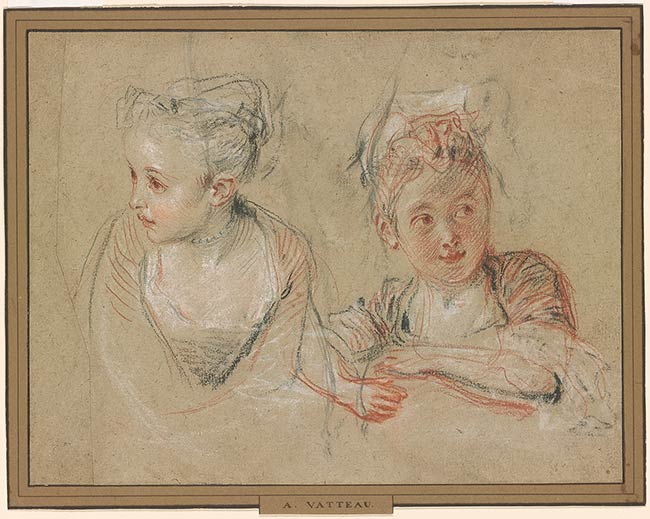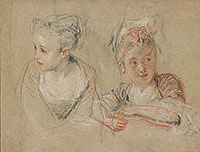
Watteau rarely made drawings that were directly preparatory for painted compositions. Instead he produced a large number of sheets of studies from life of men, women, and children in various poses that he kept in his studio and used when needed. According to Père P. A. Orlandi, who wrote the only biography of the artist published during his lifetime (1719), in the works of Watteau, "one finds a truth to nature that infinitely delights; the animation he gives to the chosen figures, the drawing is correct, the turns of the heads are beautiful, the draperies and the folds are well-disposed, the coloring is good, with a mellow and confident touch...”
Watteau often reused in paintings the figures on his study sheets. The study at right was used for the figure of a little girl, seated at her mother's knee, listening to a concert, in the painting The Music Lesson of ca. 1717-18 (Wallace Collection, London, P377), titled Pour nous prouver que cette belle in Jean de Julienne's contemporary engraving after the painting. The model has not been identified, although she appears again in another sheet of studies in the Musée des Beaux-Arts, Orléans, which is related to the figure of a little girl holding a dog in the engraving L'Amour paisible. The figure in the Orléans sheet is close to the right hand study in the present drawing, albeit shown at a less attractive angle with her head raised and turned to the left. Pierre Rosenberg and Louis Antoine Prat concluded that both sheets of studies must have been made at the same sitting, and like Margaret Morgan Grasselli, date the sheet to 1717. That year, after long delays, Watteau finally submitted his reception piece to the Académie and was officially received. By the end of the year he was living at the house of his patron, Pierre Crozat.
Before the studies of two girls were drawn, the present sheet contained a study of legs oriented at ninety degrees. Rosenberg and Prat remarked that the delineation of the legs was heavy and clumsy and questioned its authorship, although they noted that at least once Watteau drew on a sheet already containing a drawing by Charles La Fosse (1636-1716). Grasselli suggested a connection between the leg study and the legs of the statue of a nymph found in the engravings after Watteau Leçon d'amour, Le Bosquet de Bacchus, and Divertissements champêtres.
Although Pierpont Morgan purchased his drawing collection of nearly sixteen hundred sheets en bloc from Charles Fairfax Murray in 1909, he acquired a small number of individual drawings-many of them eighteenth century works--during the last fifteen years of his life. Both this and a second sheet by the artist (I, 278a) were bought by Morgan from Agnew's in 1912.
Watermark: none visible through lining.
There is an irregular vertical strip added to the left side of the sheet.
James, Andrew, former owner.
James, Sarah Ann, former owner.
Morgan, J. Pierpont (John Pierpont), 1837-1913, former owner.
New York World's Fair : Illustrated Catalogue of an Exhibition Held on the Occasion of The New York World's Fair. New York : Pierpont Morgan Library, 1939, no. 96.
Treasures from the Pierpont Morgan Library : Fiftieth Anniversary Exhibition. New York : Pierpont Morgan Library, 1957, no. 99, pl. 63.
Denison, Cara D., and Helen B. Mules, with the assistance of Jane V. Shoaf. European Drawings, 1375-1825. New York : Pierpont Morgan Library, 1981, no. 100, repr.
Denison, Cara D. French Drawings, 1550-1825. New York : Pierpont Morgan Library, 1984, no. 40, repr. in color (detail, front cover)
Denison, Cara D. French Master Drawings in the Pierpont Morgan Library. New York : Pierpont Morgan Library, 1993, no. 39, repr. in color, and repr. in color on front cover.
Pierre Rosenberg and Louis-Antoine Prat, "Antoine Watteau 1684-1721, Catalogue raisonné des dessins", 3 vols., Milan, 1996, II, no. 558, p. 946, repr. in color.
From Leonardo to Pollock: Master drawings from the Morgan Library. New York: Morgan Library, 2006, cat. no. 75, p. 158-159.

